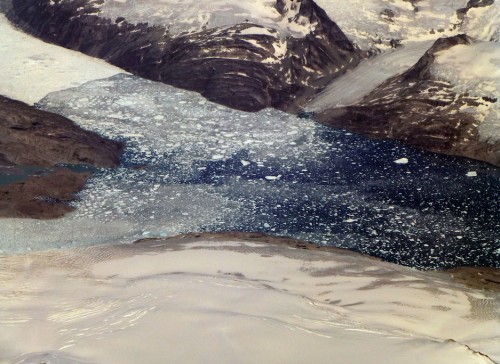Featured Stories | July 16, 2013
Where Ocean Meets Ice, All Eyes on Greenland
As the importance of Greenland to future sea-level rise grows, the observationalists and modelers must come together to understand the complex role of the ocean in glacial melting.
By Genevieve Wanucha
The idea that the ocean plays a large role in glacial melting and marine ice sheet destabilization dates back to the 1970s speculations of glaciology giants Johannes Weertman, Terrence Hughes, and John Mercer. Only in the last 5 years or so has it gained full momentum. Illuminated by satellite images, all the surprising changes in Antarctica and Greenland’s ice sheet have occurred where ocean meets ice, prompting the realization that warming ocean waters may lick away at the marine edges and amplify melting and, ultimately, sea level rise.
Antarctica’s melty underbelly has claimed the recent spotlight. Yet, according to physical oceanographer Patrick Heimbach, Principal Research Scientist in MIT’s Department of Earth, Atmospheric and Planetary Sciences (EAPS), in terms of predicting sea level rise far into the future, the ice-ocean dynamics on the narrow fjords of Greenland’s ice sheet warrant special attention.
It may at first seem odd that Greenland would be crucial to sea level predictions. Whereas Greenland’s net mass loss during the last two decades appeared to add little to the total observed sea level rise, recent increases in its discharge since the mid-2000s, combined with reduced mass loss from other glaciers and ice caps, helped its rise to prominence in contributing roughly one quarter to global mean sea level rise, though numbers remain rather uncertain. “The worrying thing,” Heimbach says, “is the potential for this process to accelerate.” Several climate-ocean factors make Greenland a prime candidate for unforeseen change in mass loss or melting speed.
Ice-Ocean Interface

First and foremost, the Greenland’s Arctic home is warming at twice the global average due to various physical processes rendering it more sensitive to climate change. At the same time, the water masses that contact the fjords in Greenland hail from the subtropical North Atlantic, so they are actually warmer than the similar type of water masses in Antarctica.
Secondly, Greenland’s geometry makes it especially vulnerable to processes that trigger and intensify melting. In the summer melt season, lots of meltwater coats the surface of the ice sheet, which drains to the bed, travels to the base of the glacial terminus, and discharges hundreds of meters below the surface. Lighter than the salty seawater, it rises as a very strong buoyant plume at the front of glaciers bathing in fjords. Along the way, it drags up warm surrounding water, providing more heat for more melting along the ice front. “Evidence from observational and modeling we’ve been doing at WHOI and MIT suggests that this plume can actually amplify the melting and, through it, potentially the calving of ice blocks compared to if that discharge water wasn’t there, says Heimbach.” It’s a tangled mix of forces conspiring to dissolve Greenland’s marine margins.
The issue of the moment is that seemingly impenetrable walls stand in a researcher’s way of understanding the mechanisms and causes of melting at Greenland’s ocean-ice interface—both a lack of measurements and the current inability of models to capture small-scale events unfolding at a glacier’s edge. “If we can’t understand the causes of mass loss, we can’t predict its contribution to sea level rise because we don’t have the information about how it could change,” says Heimbach. Unsurprisingly, the dynamic response of the Greenland glaciers to climate change has become a recognized font of uncertainty in sea level rise projections. In fact, the 2007 Intergovernmental Panel on Climate Change (IPCC) Fourth Assessment Report (AR4) lists it as the largest source of uncertainty.
Bridging the Divide
It was this exactly that occupied Heimbach’s mind while he helped organize a 2010 climate dynamics summer school in Norway. There, he met up with Fiamma Straneo of Woods Hole Oceanographic Institution and Olga Sergienko of Princeton University and the NOAA Geophysical Fluid Dynamics Laboratory, and all began to discuss pushing this Arctic problem up a level into the research agenda of the U.S. Climate Variability and Predictability Research Program. This interagency organization, known as CLIVAR, had no previous focus on land ice, but soon accepted Heimbach and his colleagues’ proposal to research Greenland ocean-ice interaction and its relevance to future sea level rise.
The MIT-WHOI effort born in Norway all came together at last month’s U.S. CLIVAR Workshop in Beverly, MA. The attendees numbered over 90 people and comprised glaciologists, oceanographers, meteorologists, and paleoclimatologists, including modelers and observationalists from all fields, in what was a long needed week for Greenland science.
While technical and practical reasons make Greenland research daunting, there’s also another issue plaguing progress: a distance between people who make measurements and those who model the ice sheet physics on a computer. “I see the divide quite often,” says Heimbach, who organized the workshop, “a misunderstanding between what each are trying to achieve. The field is project-driven, so there are modeling projects and there are observational projects, and there is rarely incentive to talk. The modeling has its set of problems that observationalists don’t appreciate. And vice versa.”
The workshop provided an antidote for this gap, if only for a week. Researchers came prepared to truly participate in the discussion sessions, which led to intense and extensive discussions. And the questions were endless. People often braved asking simple questions to clear up terminology confusions between glaciologists and oceanographers.
Discussing the (Nearly) Impossible
The pulse of Greenland ice-ocean research is in the contents of this CLIVAR workshop. Much discussion surrounded the physical processes defining Greenland’s ice-ocean interaction—submarine melting and calving–which happens when ice blocks detach from the glacier, falling vertically until they flip over in the ocean. “The interesting thing to me, not being a glaciologist,” says Heimbach, “is the complexity of calving dynamics and how difficult it is to understand calving.”
Studying calving is so perplexing because, well, calving isn’t kind to the methods of science. “At the moment, we don’t have the technological capability of making measurements close to calving fronts because it calves intermittently, and the area is covered with sea ice mélange and calving debris, so there’s no place to put an instrument,” he says. “And nobody is willing to put expensive autonomous underwater vehicles (AUVs) out there because they will likely never come back up.”
Measuring the discharge coming from under the glacier, or ‘subglacial discharge’, is also a conundrum. The glaciologists at the workshop noted the factor of 4 difference between the groups trying to estimate surface melting. Moreover, meltwater sometimes rests in subglacial lakes before it gets discharged, so there’s no direct 1 to 1 connection between surface melting and the water flushing out.
A NASA manager stood up at one point: “Gee, NASA is good at solving these grand technological problems of flying to space. It should be a NASA mission to develop technologies to take these measurements required to sort out what’s going on here.”
The lack of reliable measurements contributes to the challenges in modeling ice-ocean dynamics. Global scale simulations are run at resolutions far too coarse to resolve Greenland’s fjords. The typical IPCC models have grid boxes under 100 km; fjords are less than one grid box. “We can run models and do ‘what-if’ experiments,” says Heimbach. “But we really can’t use them for predictions because we don’t yet have the measurements to validate the models.” But he had some more optimistic news on the modeling front.
Using the innovative MITgcm (MIT General Circulation Model). Heimbach and MIT post doc Roberta Sciascia have taken the same model code used in global scale models and configured it to have an almost 10-meter resolution near the glacier terminus. “We are trying to zoom into very small-scale processes to try to understand the processes and translate these results into the global-scale models,” says Heimbach.
Meanwhile, MIT-WHOI graduate student Rebecca Jackson is preparing for her third trip to Greenland’s southeastern Sermilik fjord where she and Straneo hope to recover a set of oceanographic moorings, which are a collection of devices connected to a wire and anchored on the sea floor. They plan to deploy a new one and hope to harvest data that could challenge existing models.
And so everyone left hoping that the next workshop would bring talk of miracle measurements and enhanced resolution models. And perhaps an Arctic-bound AUV or two.


 More of Heimbach’s detailed thoughts on this topic:
More of Heimbach’s detailed thoughts on this topic: 


